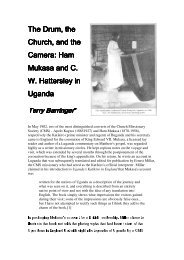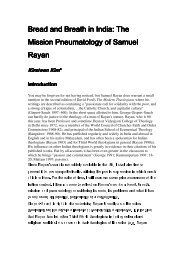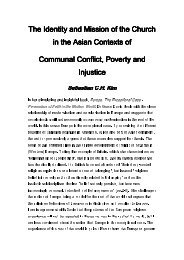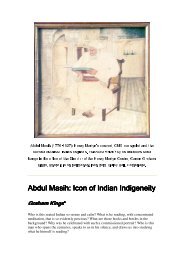The Legacy of Johann Ludwig Krapf - Henry Martyn Centre
The Legacy of Johann Ludwig Krapf - Henry Martyn Centre
The Legacy of Johann Ludwig Krapf - Henry Martyn Centre
Create successful ePaper yourself
Turn your PDF publications into a flip-book with our unique Google optimized e-Paper software.
in Pietism. In Travels, Researches, and Missionary Labours in East Africa he tells us little about his family except that his father was a comfortably-<strong>of</strong>f farmer and that he was one <strong>of</strong> four children. He seems to have been an overserious child; he suffered a six-month-long illness following a severe beating for a fault he did not commit, and reported, 'Left to myself my immersed<br />
dwelt much upon eternity; and the reading <strong>of</strong> the Bible and devotional books became my delight."[8] He might never have gone beyond elementary schooling, but as the result <strong>of</strong> a chance encounter by his sister, he was sent to the Österbergschule in Tübingen, where he received an education that prepared him for university.[9] thoughts<br />
school he quickly caught up with his contemporaries and then outstripped them, soaking up languages like blotting paper. He learned Latin and Greek and made a start on French and Italian; when he decided to go to the Basel At<br />
Institute, he prepared himself by learning Hebrew and before long had "read the greater portion <strong>of</strong> the Old Testament in the original."[10] He spent from May 1827 to May 1829 at Basel but then came to doubt his missionary call, and he returned to Tübingen to spend the next five years studying theology.[11] He was ordained in the autumn <strong>of</strong> 1834. After less than Missionary<br />
year's not altogether happy parish experience, he met Peter Fjellstedt, a Basel-trained Swedish missionary, who rekindled his missionary call and encouraged him to <strong>of</strong>fer to the CMS.[12] He returned to Basel, where, in 1836, he met Dandeson Coates, lay secretary <strong>of</strong> CMS, and was accepted by that society. When assigned to Ethiopia, he set to work to study "Aethiopic," a<br />
known as Ge'ez, the archaic language <strong>of</strong> the church, and Amharic, the modern speech <strong>of</strong> the Christian Amhara people, besides studying some Arabic. He also read the History <strong>of</strong> Ethiopia by the great seventeenth-century properly<br />
Vision in Ethiopia<br />
<strong>Krapf</strong>'s first posting was to Ethiopia, where he worked from 1837 to 1842, when he<br />
was forced to return to Cairo. Here he made his first long overland journey, and<br />
armed already with some knowledge <strong>of</strong> Ge'ez and Amharic, he set out to master the<br />
Cushitic speech <strong>of</strong> the Oromo people (whom he knew as the Galla), the dominant<br />
people throughout much <strong>of</strong> central and southern Ethiopia. His first publications date<br />
scholar Hiob Ludolf.[13] Vision in Ethiopia Vision in Ethiopia Vision in Ethiopia German







